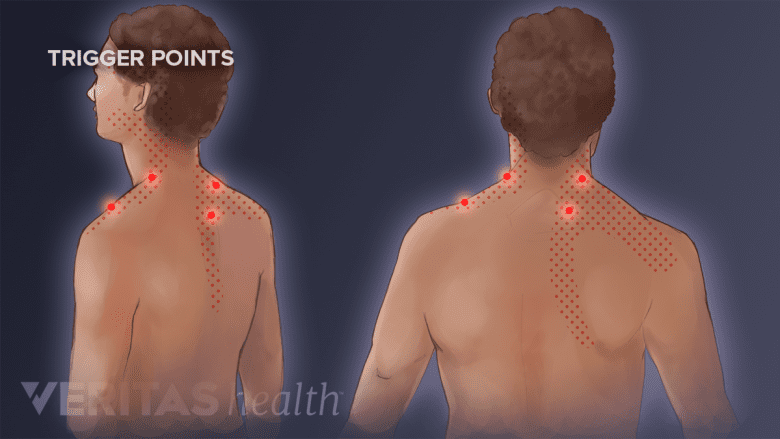Most neck strains heal on their own, but finding the right treatment can help alleviate the pain while the injury is healing. In cases where neck pain lingers for more than a few days or initial treatments do not provide enough relief, trial-and-error may be needed to find the combination of treatments that work best.
In This Article:
- Neck Strain: Causes and Remedies
- Neck Strain Symptoms
- Neck Strain Diagnosis
- Neck Strain Treatments and Prevention
- Neck Strains and Sprains Video
- Treatment for Neck Strain or Sprain Video
Initial Treatments for Neck Strain
When pain from a neck strain first develops, one or more of the following treatments are typically tried:
Activity modification

A short period of rest can help calm the acute symptoms of neck pain.
Resting the neck and/or refraining from strenuous activities for a couple days can give the muscle or tendon time to start healing and feeling better. Trying to push through the pain without reducing activity levels could worsen the injury and prolong the pain.
Ice and/or heat therapy

Ice and heat therapy are effective self-care treatments for neck strain.
It is recommended to apply ice within the first 48 hours of an injury to help reduce swelling. After 48 hours, heat or ice may be applied, depending on the patient’s preference. Heat therapy can help facilitate blood circulation and bring healing nutrients to the damaged tissues. A layer should be kept between the skin and hot/cold source to avoid skin damage, and applications should be kept to 10 to 20 minutes with rest periods in between.
Watch How to Apply Heat Therapy for Neck Pain Relief Video
Over-the-counter pain medication

OTC medication may provide temporary relief from muscle pain.
Taking anti-inflammatory medicines, such as ibuprofen (e.g. Advil) or naproxen (e.g. Aleve), reduces inflammation, which in turn can reduce pain. Pain relievers, such as acetaminophen (e.g. Tylenol), may also be an option.
It should be noted that even if a neck muscle strain is painful with most movements, total bed rest and/or a neck brace are not typically recommended because that could lead to weaker neck muscles and a longer recovery period.
Treatments for Neck Strains That Linger
If a neck strain lasts longer than a few days or perhaps another underlying problem in the cervical spine continues and causes muscle spasms and chronic pain, other treatments may need be needed for adequate relief. Some examples include:
Physical therapy

The chin tuck exercise strengthens the muscles of the neck and shoulder.
A physical therapist, physiatrist, or other trained medical professional may design a physical therapy program that targets muscles in the neck and elsewhere that need to become stronger and more flexible. Typically, a physical therapy program begins with instruction on how to do the exercises and stretches. After gradually making process over a period of a few weeks or months, the patient continues the program on his or her own at home.
Manual manipulation
A trained medical professional may make manual adjustments to the cervical spine (as well as lower in the spine) with the goal of realigning joints, improving the neck’s range of motion, and reducing pain.
Massage therapy

Massage may help loosen tight muscles and induce relaxation.
A massage can loosen up and relax the muscles, as well as increase blood flow to the damaged tissues, which may provide some relief. Some medical professionals provide massage therapy in conjunction with manual manipulation.
Acupuncture

Acupuncture treatment may help alleviate neck pain and provide relief.
This treatment is based on the theory that unbalanced energy flows (or blockages) within the body may contribute to pain, and therefore strategic placements of thin needles in the body may restore balanced energy flows and reduce pain. While this theory has not been scientifically proven, some people report experiencing pain relief from acupuncture treatments.
Prescription medications

Muscle relaxants may help reduce painful muscle spasms in the neck and surrounding muscles.
While rare, sometimes a neck strain may require a prescription medication to provide relief. For example, a muscle relaxant may be prescribed on a short-term basis to alleviate the pain from a particularly bad muscle spasm.
See Medications for Back Pain and Neck Pain
This is not a complete list of neck strain treatments, and other treatments may be recommended by a doctor.
Reducing the Risk of Neck Strain
While not all neck strains can be prevented, some basic steps can reduce the risks.
- Stay active. A physically active lifestyle keeps the whole body relatively strong and flexible, including the neck. In addition, regularly performing exercises and stretches that target the neck and core muscles can help improve posture as well.Many neck strains result from poor posture due to deconditioned neck muscles.
- Start slowly. When starting a new activity or sport, begin at a manageable pace or workload, then gradually build up over time. It is common to strain a muscle when performing a new or unfamiliar activity.
- Take breaks. Repetitive motions can lead to muscle strain, including in the neck. Taking breaks or alternating activities enables muscles to rest and recover to avoid injury.
- Sleep well. Finding the right pillow, mattress, and sleep position can reduce the risk for waking up with neck pain. However, everyone is different, and it could take trial-and-error before settling on what works best. For example, sleeping on the stomach causes the most stress on the cervical spine, but not everyone agrees as to whether sleeping on the side or on the back is better. Also, some people prefer a cervical pillow, but others may find more comfort with other pillows.
- Focus on posture. Sitting and standing up straight with shoulders back helps keep the spine in neutral alignment. Remembering to use good posture throughout the day helps minimize the forces acting on the intervertebral discs and ligaments.
Having a strained neck increases the risk for it to happen again in the future. Also, trying to return too quickly from a neck strain injury before it heals can worsen the injury and prolong the recovery period.

